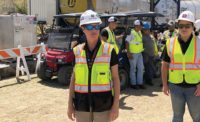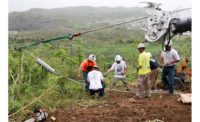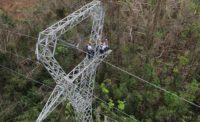It’s March 20—day 182 for the Louis Berger temporary power mission in Puerto Rico. At peak, the company had installed more than 1,600 generators. On this date, there are still 869 generators requiring about 40,000 gallons of diesel fuel daily, supplying power to hospitals, water pump stations and even entire towns.
The mission far surpasses any previous temporary power mission assigned by the Corps of Engineers. Following Hurricane Irma, the Corps installed 50 generators in Florida.
The Puerto Rico mission shows no signs of coming to an end. The local utility says close to 95% of power has been restored, but that power is unreliable. Feeder lines to the islands of Vieques and Culebra were damaged, leaving the 10,000 people there reliant on microgrids created with massive 1,825-kW diesel generators. Louis Berger installed those microgrids and seven others around Puerto Rico. The microgrids use a bank of the large generators and are connected through a modified substation to the area’s distribution lines.
Tom Lewis, president of Louis Berger U.S., is one of the first to acknowledge that diesel generators aren’t the best way to continue to provide power.
The diesel generators are inefficient and expensive. “You typically don’t use diesel for the long term,” he says.
At the least, Louis Berger would like to install hybrid solar-diesel generators to provide temporary power. Ideally, the company would like to install permanent solar-based microgrids that are able to provide power until grid power is restored and then provide backup power.
To prove the performance of such a hybrid solar-diesel system, Louis Berger and partners WestGen and AEG in January installed pro bono two mobile solar-diesel hybrid generators at La Perla de Gran Precio, a shelter for women and children in Bayamón.
When the power came back on, says Delyris Rivera, director of the children’s shelter, the children “were very happy. They started screaming because they could watch TV.” Before the generators were installed, the women at the shelter had to maintain and fuel the existing generators, which operated only on a limited basis. “It was a nightmare,” says Rivera.
At its own cost, Louis Berger will replace the temporary hybrid with a permanent microgrid to power the shelters and possibly an adjoining rest home, Lewis says. The microgrid will have up to 200 kW of battery storage, 50 kW of solar capacity and a 100-kW diesel generator.
The company also expects to make unsolicited proposals to the Puerto Rico government to install similar microgrids throughout the island. “My hope is that we would be building something in the not-too-distant future,” Lewis says.
Mind-Blowing Effort
In the meantime, however, the company is operating, maintaining and managing hundreds of government-owned generators around the island under its $415-million contract with the Corps.
One of those leading the effort for Louis Berger is Kris Caldwell, incident commander for installations and deinstallations. Caldwell arrived in Puerto Rico Sept. 12, weathered Maria and hasn’t left. The company’s 1,100 technical personnel, including subcontractors, work 121⁄2 hours a day, seven days a week.
On a recent tour, she proudly pointed out the generators providing power to the water systems pump stations. Of the remaining generators, 500 power the pump stations. Around those generators, Caldwell pointed out laundry hanging from lines outside storm damaged homes with blue roofs. “They may not have power, but I know they have water,” she says.
Caldwell says it is “mind-blowing” how subcontractors, the majority of them local, managed to transport the generators over mountain roads and place them in remote locations. “People look at the map and say ‘you can go there, or you can go here,’ but no, you couldn’t just go there,” she says. “I’ve come to understand there’s nothing easy on this mission except for the people of Puerto Rico.”
By Pam Radtke Russell with Scott Blair in Puerto Rico







Post a comment to this article
Report Abusive Comment